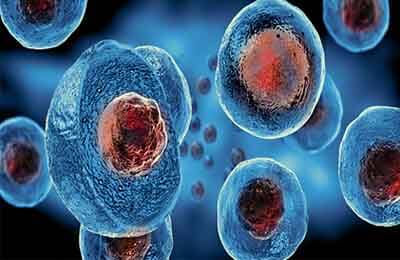肿瘤线粒体DNA损伤修复的研究进展
时间:2022-09-30 05:52:33

[摘要]线粒体是哺乳动物细胞中唯一存在于细胞核外又带有遗传物质线粒体DNA(mtDNA)的细胞器。mtDNA支持和参与诸多重要的细胞功能。mtDNA因其特殊的结构和遗传学地位,易受各种因素的损伤。当损伤发生时,线粒体内的DNA损伤修复因子,诸如线粒体转录因子A、mtDNA聚合酶-γ、8-氧鸟嘌呤DNA糖基化酶等参与修复过程,而整个修复过程受到上游相关因子的调控。
[关键词]线粒体;肿瘤;线粒体转录因子A;线粒体DNA聚合酶;8-氧鸟嘌呤DNA糖基化酶
[中图分类号]Q 754[文献标志码]A[doi]10.3969/j.issn.1673-5749.2012.04.017
Research progress on mitochondrial DNA damage repair in tumorsLi Hejia1, Zhu Yang2, Li Dechao2.(1. Dept. of Prosthodontics, The Affiliated Stomatological Hospital of Jiamusi University, Jiamusi 154004, China; 2. Dept. of Oral and Maxillofacial Surgery, The Affiliated Stomatological Hospital of Jiamusi University, Jiamusi 154004, China)
[Abstract]Mitochondria are organelles in mammalian cells, with the only genetic material outside the nucleus mitochondrial DNA(mtDNA). It supported and participated in many important cellular functions. MtDNA vulnerabled to a variety of factors and cause damage because of special structures and advancement of genetics. When mtDNA damage happened, some mtDNA repair factors, such as: Mitochondrial transcription factor A, mtDNA poly-merase-γ, 8-oxoguanine DNA glycosylase enzymes take part in the damage repairing. The entire repair process were regulated by related factors.
[Key words]mitochondria;tumor;mitochondrial transcription factor A;mitochondrial DNA polymerase;8-oxoguanine DNA glycosylase
线粒体是真核细胞内重要的细胞器,提供细胞所需能量的95%,参与诸多生物学功能,譬如能量产生、呼吸作用、脂质合成和氨基酸代谢并维持细胞内电离平衡[1],拥有唯一存在的独立于细胞核DNA(nuclear DNA,nDNA)之外的遗传物质线粒体DNA(mitochondrial DNA,mtDNA)。下面就mtDNA的结构与功能、mtDNA的损伤与修复及其调控因子作一综述。
1mtDNA的结构与功能
人类mtDNA基因组结构简洁,仅有16 569对碱基对,形成一个双链闭环超螺旋DNA,由分别具有独立功能的富含鸟嘌呤的重链(H)和富含胞嘧啶的轻链(L)组成[2-3]。mtDNA基因组包含了37个基因(重链28个,轻链9个),相邻的基因间除取代环(D-Loop)区域外极少有非编码基因。mtDNA可独立于nDNA之外自主地进行复制、转录和翻译,具有非常活跃的自我复制能力。一个线粒体中可含有2~10个拷贝的mtDNA,整个细胞可含有1 000多个拷贝的mtDNA。mtDNA编码和翻译22种转移RNA(transfer ribonucleic acid,tRNA)、2种核糖体RNA(ribosomal RNA,rRNA)和13种氧化磷酸化相关蛋白质[2]。所有这些蛋白质均是呼吸链的组成成分,位于线粒体内膜[4]。
2mtDNA损伤
mtDNA发生突变的概率是nDNA的10倍[5]。mtDNA损伤的原因如下:1)mtDNA几乎不受DNA结合蛋白的保护;2)mtDNA几乎不存在非编码区,任何位点的突变都可能被转录,造成蛋白质表达改变;3)mtDNA易受致癌因素,诸如化学诱变剂、电离辐射和紫外线等的影响而损伤;4)mtDNA复制频率和次数较nDNA高,容易受外界因素的干扰,稳定性差;5)其D环区是单链启动复制,易使tRNA基因部位出现发夹样结构,增加错配机会,导致mtDNA基因突变;6)缺乏有效的DNA修复系统;7)线粒体内的高氧环境和高脂含量[6-8]。由此可见,mtDNA是较易受攻击的靶分子,常发生损伤与突变。又因为mtDNA在体内分布非常广泛,故其损害可影响到全身多个器官和系统,所以有关其与疾病的关系受到了学者们的广泛关注。研究[8]显示,肿瘤的发生发展过程以及肿瘤对化疗药物及射线的耐受也与mtDNA损伤和修复密切相关。
3mtDNA的损伤修复
mtDNA的损伤与nDNA损伤一样,若得不到及时有效的修复,细胞将发生基因突变和癌变等严重后果。长期以来,人们普遍认为线粒体中不存在DNA的修复,并认为这是造成mtDNA损伤积累的原因。尽管mtDNA自身并不编码任何DNA修复蛋白,但是随着研究的深入和检测手段的进步,人们已在线粒体提取物中检测到了一定数量的修复因子,并证明其确实存在[9]。其中,包括参与清除DNA中单个突变碱基的碱基切除修复途径(short-patch base excision repair,SP-BER)、碱基片段切除修复途径(long-patch base excision repair,LP-BER)、错配修复和同源重组等相关的酶[10-11],提示线粒体中存在DNA修复。然而,涉及mtDNA损伤修复的系统却极为复杂,许多环节及所含成分还远未被明确。
3.1线粒体转录因子A
线粒体转录因子A(mitochondrial transcription factor A,Tfam)是核编码的与mtDNA复制、转录和修复有关的碱性蛋白质,是已知的唯一存在于哺乳动物线粒体中的转录因子。Tfam由位于核染色体10q21的基因编码,含有204个氨基酸,相对分子质量为2.5×105,属于高速泳动族蛋白成员[12]。Tfam不仅对mtDNA的表达必不可少,而且对mtDNA的维护与修复也是至关重要的。成熟的人类Tfam直接与重链启动子和轻链启动子结合而激发线粒体基因的转录,并调节mtDNA的拷贝数量。虽然人的Tfam不是十分丰富,但是却足以覆盖mtDNA的全部区域[13]。这提示人的DNA并不,对诸如活性氧类反应产物的攻击有一定的防护能力。有研究[14]显示,程序性细胞死亡的增加与Tfam表达减弱相关。其机制与Tfam-P53结合有关,Tfam同P53的相互作用还在DNA的损伤与修复中发挥重要作用[15]。Kidani等[12]发现,顺铂耐药细胞系中Tfam的表达水平明显增高。一项关于子宫内膜腺癌的研究[16]显示,Tfam的表达可作为判断肿瘤发展和预后的指标。
3.2mtDNA聚合酶-γ
mtDNA聚合酶-γ(mtDNA polymerase gamma,POLG)是迄今为止唯一存在于脊椎动物的线粒体DNA聚合酶,其编码基因位于染色体15q24,共有23个外显子[17]。POLG由相对分子质量为1.4×105的催化相关的α亚单位和相对分子质量为4.1×105的加工相关β亚单位构成二连体,定位于线粒体内膜,参与mtDNA复制和修复[18]。亚单位含有聚合酶和核酸外切酶的活性,可促进DNA的结合和合成。在DNA修复过程中,POLG分为SPBER和LP-BER修复途径,对于SP-BER,POLG一次只能插入一个核苷酸到缺口处,而LP-BER则涉及多个核苷酸的插入,一般2~7个[19]。POLG与DNA连接酶一起维系线粒体基因组的稳定[20]。碱基切除修复途径已经通过包括聚合酶-γ在内的线粒体中的酶在体外得到重建[21]。在mtDNA完全阙如的细胞中,POLG基因仍能稳定地表达和翻译,即POLG除了参与mtDNA复制外,亦可能参与细胞的其他重要事件。研究[17,22]显示,POLG基因的突变与乳腺癌和精原细胞瘤的发生密切相关。
3.38-氧鸟嘌呤DNA糖基化酶1
人8-氧鸟嘌呤DNA糖基化酶(8-oxoguanine DNA glycosylase,OGG)1基因定位于染色体3p26.2,属于管家基因,由7个外显子和6个内含子组成。OGG1蛋白在细胞核和线粒体中均有分布,在人类基因组DNA氧化损伤的修复中起重要作用[23],在DNA氧化损伤中,8-氧鸟嘌呤(8-oxoguanine,8-oxoG)形成率高、致突变能力强,被公认为DNA氧化损伤和细胞内氧化应激的指示剂,与肿瘤的发生和发展关系也最为密切。由于许多内源性和外源性致癌物可产生8-oxoG,所以修复8-oxoG的能力与个体对致癌物作用的敏感性密切相关。OGG1蛋白可识别并切除氧化应激产物8-oxoG[24],这在防止8-oxoG的致突变作用中起着十分重要的作用。此外,OGG1蛋白还具有脱嘌呤或脱嘧啶(AP)裂解酶活性,可在糖基化产生的AP位点处将DNA链切除,以修复自发性碱基丢失,可阻断DNA复制的AP位点[25]。研究[26]显示,OGG1蛋白与血管平滑肌脂肪瘤的发生相关。Liddiard等[23]认为,OGG1蛋白可用于急性髓性白血病传统化疗失败患者的预后标志物。
4mtDNA损伤修复的调控
Tfam、POLG和OGG1三种mtDNA损伤修复因子的活性受到其相关因子的调控。磷脂酰肌醇-3-激酶(phosphatidylinositol-3-kinase,PI3K)/蛋白激酶B(protein kinase B,PKB)信号转导通路影响它们的表达水平,因为Tfam含有核呼吸因子(nuclear respiratory factor,NRF)的结合位点,PI3K/ PKB信号转导通路通过调节NRF的活化调节Tfam基因的表达[27]。尽管OGG1和POLG基因表达的调节尚不清楚,但OGG1启动区包括NRF-2和SP-1两个结合位点,POLG基因启动区有一个可能被NRF-1识别的DNA结构域[28],POLG的β亚单位受到NRF-2的调控[29];因此,PI3K/PKB通路对OGG1和POLG表达的水平有影响。一项有关口腔鳞状细胞癌的研究[27]证实,PI3K/PKB抑制剂可下调射线诱导的Tfam、OGG1和POLG蛋白的表达,则提示PI3K/PKB信号转导通路可调控这三种mtDNA损伤修复因子。
5展望
毋庸置疑,mtDNA损伤修复对维持线粒体功能与mtDNA的完整性有着重要的意义。随着研究的深入,将有越来越多的损伤修复因子被发现,并熟知其相关的调控,从而更全面地了解mtDNA损伤修复。目前,有关mtDNA损伤修复与肿瘤的发生发展及耐受等相关问题的研究仍然需要进一步深入,从而更好地指导肿瘤的预防和治疗。
6参考文献
[1]De Pauw A, Tejerina S, Raes M, et al. Mitochondrial(dys)function in adipocyte(de)differentiation and systemic metabolic alterations[J]. Am J Pathol, 2009, 175(3):927-939.
[2]Anderson S, Bankier AT, Barrell BG, et al. Sequence and organization of the human mitochondrial genome[J]. Nature, 1981, 290(5806):457-465.
[3]Glater EE, Megeath LJ, Stowers RS, et al. Axonal transportofmitochondriarequiresmiltontorecruit kinesin heavy chain and is light chain independent[J]. J Cell Biol, 2006, 173(4):545-557.
[4]Chan DC. Mitochondria:Dynamic organelles in disease, aging, and development [J]. Cell, 2006, 125(7):1241 -1252.
[5]Longley MJ, Nguyen D, Kunkel TA, et al. The fidelity of human DNA polymerase gamma with and without exonucleolytic proofreading and the p55 accessory subunit[J]. J Biol Chem, 2001, 276(42):38555-38562.
[6]Hayashi Y, Yoshida M, Yamato M, et al. Reverse of age -dependent memory impairment and mitochondrial DNA damage in microglia by an overexpression of human mitochondrial transcription factorαin mice[J]. J Neurosci, 2008, 28(34):8624-8634.
[7]王耀钟,贾暮云,袁荣涛,等.口腔鳞状细胞癌线粒体DNA高变Ⅱ区及高变Ⅲ区突变的功能意义[J].华西口腔医学杂志, 2010, 28(3):254-260.
[8]韩国栋,袁荣涛.线粒体DNA突变与头颈肿瘤发生的研究进展[J].国际口腔医学杂志, 2010, 37(1):65-67.
[9]Holt IJ. Mitochondrial DNA replication and repair:All a flap[J]. Trends Biochem Sci, 2009, 34(7):358-365.
[10]Liu P, Qian L, Sung JS, et al. Removal of oxidative DNA damage via FEN1-dependent long-patch base excision repair in human cell mitochondria[J]. Mol Cell Biol, 2008, 28(16):4975-4987.
[11]Liu P, Demple B. DNA repair in mammalian mitochondria:Much more than we thought[J]. Environ Mol Mutagen, 2010, 51(5):417-426.
[12]Kidani A, Izumi H, Yoshida Y, et al. Thioredoxin2 enhances the damaged DNA binding activity of mtTFA through direct interaction[J]. Int J Oncol, 2009, 35(6):1435-1440.
[13]Fukuoh A, Kang D. Methods for assessing binding of mitochondrial transcription factor A(TFAM)to DNA[J]. Methods Mol Biol, 2009, 554:87-101.
[14]Wang J, Silva JP, Gustafsson CM, et al. Increased in vivo apoptosis in cells lacking mitochondrial DNA gene expression[J]. Proc Natl Acad Sci U S A, 2001, 98(7):4038-4043.
[15]Wong TS, Rajagopalan S, Freund SM, et al. Biophysical characterizationsofhumanmitochondrialtranscription factor A and its binding to tumor suppressor p53[J]. Nucleic Acids Res, 2009, 37(20):6765-6783.
[16]Toki N, Kagami S, Kurita T, et al. Expression of mitochondrial transcription factor A in endometrial carcinomas:Clinicopathologic correlations and prognostic significance[J]. Virchows Arch, 2010, 456(4):387-393.
[17]Singh KK, Ayyasamy V, Owens KM, et al. Mutations in mitochondrial DNA polymerase -gamma promote breast tumorigenesis[J]. J Hum Genet, 2009, 54(9):516-524.
[18]Chan SS, Copeland WC. DNA polymerase gamma and mitochondrial disease:Understanding the consequence of POLG mutations[J]. Biochim Biophys Acta, 2009, 1787(5):312-319.
[19]Xu G, Herzig M, Rotrekl V, et al.Base excision repair, aging and health span[J]. Mech Ageing Dev, 2008, 129(7/8):366-382.
[20]De A, Campbell C. A novel interaction between DNA ligaseⅢand DNA polymerase gamma plays an essential role in mitochondrial DNA stability[J]. Biochem J, 2007, 402(1):175-186.
[21]Pinz KG, Bogenhagen DF. Efficient repair of abasic sites in DNA by mitochondrial enzymes[J]. Mol Cell Biol, 1998, 18(3):1257-1265.
[22]Blomberg JM, Leffers H, Petersen JH, et al. Association of the polymorphism of the CAG repeat in the mitochondrial DNA polymerase gamma gene(POLG)with testicular germ-cell cancer[J]. Ann Oncol, 2008, 19(11):1910-1914.
[23]Liddiard K, Hills R, Burnett AK, et al. OGG1 is a novel prognostic indicator in acute myeloid leukaemia[J]. Oncogene, 2010, 29(13):2005-2012.
[24]Faucher F, Wallace SS, DoubliéS. Structural basis for the lack of opposite base specificity of Clostridium acetobutylicum 8-oxoguanine DNA glycosylase[J]. DNA Repair(Amst), 2009, 8(11):1283-1289.
[25]Asagoshi K, Yamada T, Terato H, et al. Distinct repair activities of human 7,8 -dihydro -8 -oxoguanine DNA glycosylase and formamidopyrimidine DNA glycosylase for formamidopyrimidine and 7,8-dihydro-8-oxoguanine[J]. J Biol Chem, 2000, 275(7):4956-4964.
[26] Habib SL. Insight into mechanism of oxidative DNA damage in angiomyolipomas from TSC patients [J]. Mol Cancer, 2009, 8:13.
[27]Ueta E, Sasabe E, Yang Z, et al. Enhancement of apoptotic damage of squamous cell carcinoma cells by inhibition of the mitochondrial DNA repairing system[J]. Cancer Sci, 2008, 99(11):2230-2237.
[28]Graziewicz MA, Day BJ, Copeland WC. The mitochondrial DNA polymerase as a target of oxidative damage[J]. Nucleic Acids Res, 2002, 30(13):2817-2824.
[29] Bruni F, Polosa PL, Gadaleta MN, et al. Nuclear respiratory factor 2 induces the expression of many but not all human proteins acting in mitochondrial DNA transcription and replication[J]. J Biol Chem, 2010, 285(6):3939-3948.(本文编辑刘世平)
